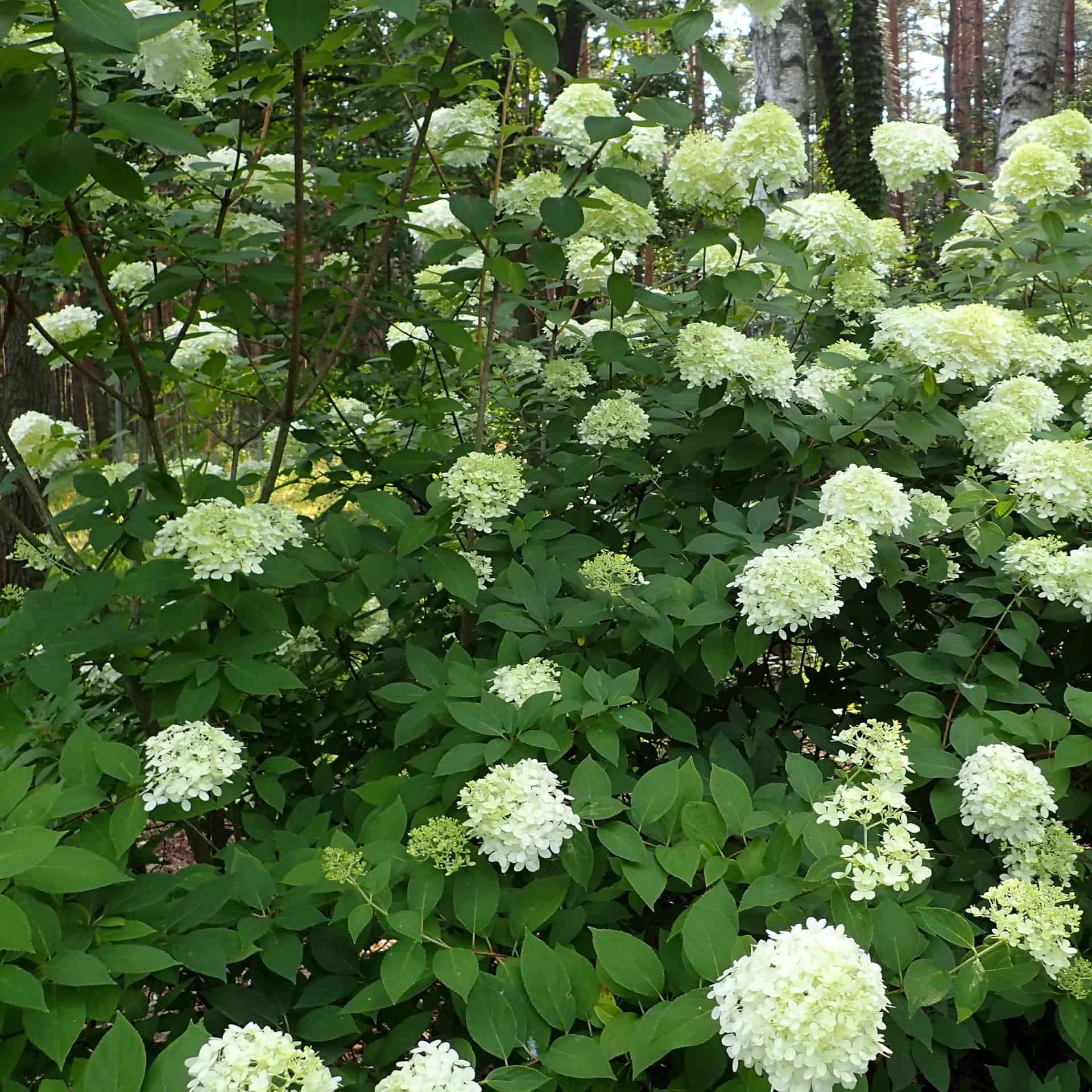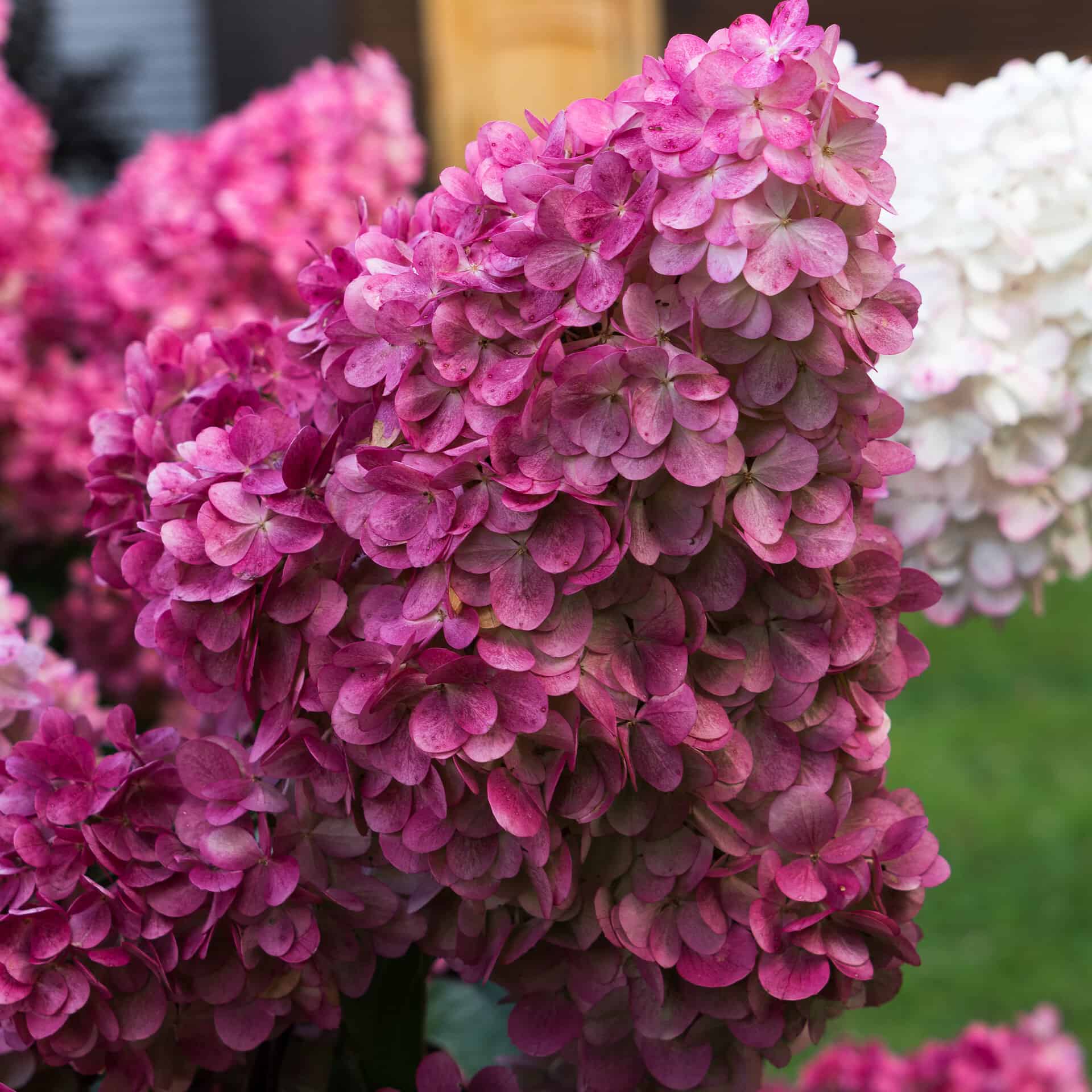No products in the cart.
Do you want a show stopper in your garden, adding beautiful color and attracting pollinators? Then the Hydrangea paniculata Fire Light is the one you should add to your flower gardens.
The Fire Light has big blooms held perfectly on strong stems.
In early summer, the blooms emerge in a creamy white, turning to a pomegranate red color. The green foliage remains full of vigor until fall. It is a no-fuss plant when it comes to caring. So, make sure to check out right here with us.
Plant Name: Hydrangea paniculata Fire Light
Other Name: Fire Light Hydrangea
Native Area: Asia
Plant Type: Shrubs
Growth: Plant height is 6 feet tall and 8 feet wide
Fertilizer: High Phosphorus Fertilizer
Light Requirement: Full Sun to Partial Shade
Propagation: Stem Cuttings
Soil Type: Well-drained soil
Temperature: Warm Temperatures and Cold Hardy
Toxicity: Toxic to Humans and Pets
Watering: Moist Soil
USDA Hardiness Zones: 3-8
More About Fire Light Hydrangea
One thing is for sure the Fire Light Hydrangea will surely get you fired up in the garden. These panicle Hydrangeas are sure winners in the garden. In early summer, the plant covered with cone-shaped flowers displays bright pink and red, changing to red tones in fall.
The woody plants have a rounded shape with dense branches adding months of color to flower gardens. Just imagine the panicle Hydrangea growing as a hedge or planted as a specimen. One thing is for sure you will rake in all the compliments of passers-by.
But why choose the Fire Light Hydrangea? These woody plants have an upright growth habit, with upright panicles blooming early to provide a more extended display of color. In addition, it offers excellent flower production for long blooming.
Furthermore, it is hardy if you do not have time to care for your garden daily. The best part is you can grow them in a mass planting with solid stems. Another highlight is it makes for the best cut flowers to use in vases or dry bouquets.
Lastly, it also makes for significant foundation plantings in the landscape and blooms on new wood.
Hydrangea Paniculata Care

From March to November, you can plant your Hydrangeas in the garden, and they are easy to grow without fuss. Most of the Hydrangeaceae family prefers a rich humus soil, and they are water-loving plants.
Still, the Fire Light Hydrangea are extremely hardy-proven winners in the garden. You can grow them in the landscape and containers. Depending on your garden design, you can grow them as shrubs or trees.
Planting Hydrangea Paniculata
When you receive your young plants, choose the best spot according to the needs below.
Dig a hole that is not deeper than the depth of the container and make it wider on the side, about six inches.
Remove your plants from the pot and trim two inches of the bottom roots using a knife if bought in a plastic container.
Then rotate your plant into position and never lift it by its tops. Instead, position the root ball and adjust so the crown is higher than the ground.
You can mix some potting medium with the ground removed and add some organic matter.
Backfill with the soil but keep the root ball top visible, allowing it to settle in as you water.
Water your young seedlings well for the first year and mulch around your plant to retain water.
The Best Soil For Hydrangea Fire Light

The Hydrangea Fire Light is cultivated in naturally rich yet productive soil. It thrives in moist soil that drains well but not soggy soil.
When overwatered, it can lead to root rot and also prefer an acidic to alkaline soil. Furthermore, the plant tolerates dry soil once the roots establish, but not for too long.
Neither does the pH level affect the flower color as in other Hydrangeas.
Best Spot For Your Panicle Hydrangeas
The best spot in the garden depends on where you live. If you live in the northern areas, it can tolerate full sun. But if you live in the south region, we recommend a spot with full sun and afternoon shade.
So, ensure your Hydrangea is not in direct sunlight in the afternoon and keep it protected from winds.
Watering Your Hardy Hydrangea
The most important thing is watering these outdoor plants well during the first growing season.
If rainfall is absent, watering is essential as the roots need to remain moist once established. If your plants show wilting foliage during dry periods in warmer areas, it helps to provide them with slow deep watering to spring back to life.
Still, ensure it has well-drained soil to prevent root rot and mulch plants to help retain moisture.
Fertilizing Hydrangeas in Early Spring

When planting the panicle Hydrangea in your flower garden and you added compost to the mix, you need not feed them. If you add a high amount of nitrogen, the leaf growth improves, but the blooms are fewer.
You can fertilize your plants with a high phosphorus feed in late winter to early spring to encourage the development of the flower heads. You can also use a granular fertilizer formulated with a higher phosphorus content, like a rose fertilizer.
Temperature and Humidity
The Fire Light Hydrangea is a hardy Hydrangea that can withstand high temperatures, in part from the sun to freezing temperatures in winter.

In hot climates, the plant needs protection against heat stress, and best to keep the soil moist. In contrast, high humidity and lack of air circulation can lead to fungal diseases.
Another reason these plants are hardy is that this cultivar blooms on new wood.
Pruning This Low Maintenance Hydrangea Paniculata
Like most other Hydrangea paniculata, the Fire Light blooms on renewed wood growth. The best time to do pruning is in early spring. You will quickly identify dead wood, spent flowers, and new growth.
You find the thick buds in the lower parts of your plant. Hence, it is best not to cut any growth below that level. You can prune your Fire Light Hydrangea to form trees with a single trunk, but the natural growth is multi-stemmed like a shrub you prune annually.
Propagating Your Fire Light Hydrangea
Your Fire Light Hydrangea rarely produces seeds, and the best propagation method is stem cuttings. Here you can find the stem-cutting process.
In early fall, pick a new stem that is not flowering, about eight inches long. Take your pruners and cut them below the leaf node. Or keep a set of leaves on it.
Then cut the foliage horizontally and divide the leaves at the bottom but keep the top leaves.
Now dip the cut end in rooting hormone and place it in a container filled with potting soil.
Moisten the soil, keep it in bright indirect sunlight, and check the soil moisture.
The root system should develop in about four weeks, and once your new indoor plant grows to a reasonable height, you can transplant them to the garden.
Panicle Hydrangea Varieties
In Hydrangea paniculata, you can find a specimen that is easy to grow in your garden. Here are two of our favorites.
Little Quick Fire

It is a dwarf variety and grows up to five feet tall to four feet wide. You find them sold in three-gallon containers. It is a deciduous shrub with green foliage with white flower heads and thrives in full sun to partial shade, turning to a vivid red as the summer progresses.
Quick Fire Fab

The shrub provides an early extended bloom, but the flowers differ from other cultivars. It grows dense football-sized mop-head, blooms in a creamy white, and turns to blush pink. Even the floret shape differs and creates an unusual textural effect.
Common Pests and Diseases
Common pests are spider mites, aphids, the four-lined plant bug, the black vine weevil, and the Japanese beetle. The insects eat the leaves, and using an insecticidal soap can kill most insects.
Another problem is drooping plants, which happens during hot weather, resulting from heat stress. For this reason, provide your Hydrangea Fire Light with enough moisture to keep them hydrated.
Yellowing leaves can also happen from under or overwatering to overfertilizing plants. In contrast, problems with blooming happen when you prune your Hydrangea Fire Light at the wrong time. Even very cold snaps can interfere with your plant’s blooms.
Frequently Asked Questions
Your panicle Hydrangea needs at least six hours of sun with some afternoon shade in warmer regions. Without enough sunlight, your Hydrangea paniculata becomes spindly as it reaches out to the light.
Planting your Hydrangea paniculata depends on where you live. For cooler climates, the best time to plant is spring to fall. In warmer temperatures, early spring to fall is recommended.
Different reasons can cause the blooms not to change to a pink-red on your plant. One reason can be not enough light, and you can improve the sun exposure by pruning them. Or it has suffered some drought or a very high temperature at night.
The Fire Light Hydrangea makes gorgeous cut flowers and is a proven winner in the garden. You can find a wide range of these beautiful shrubs to buy here with us as Plantly.
Whether you want to buy, sell, or simply reach out to other plant enthusiasts, Plantly is the right place to be!


